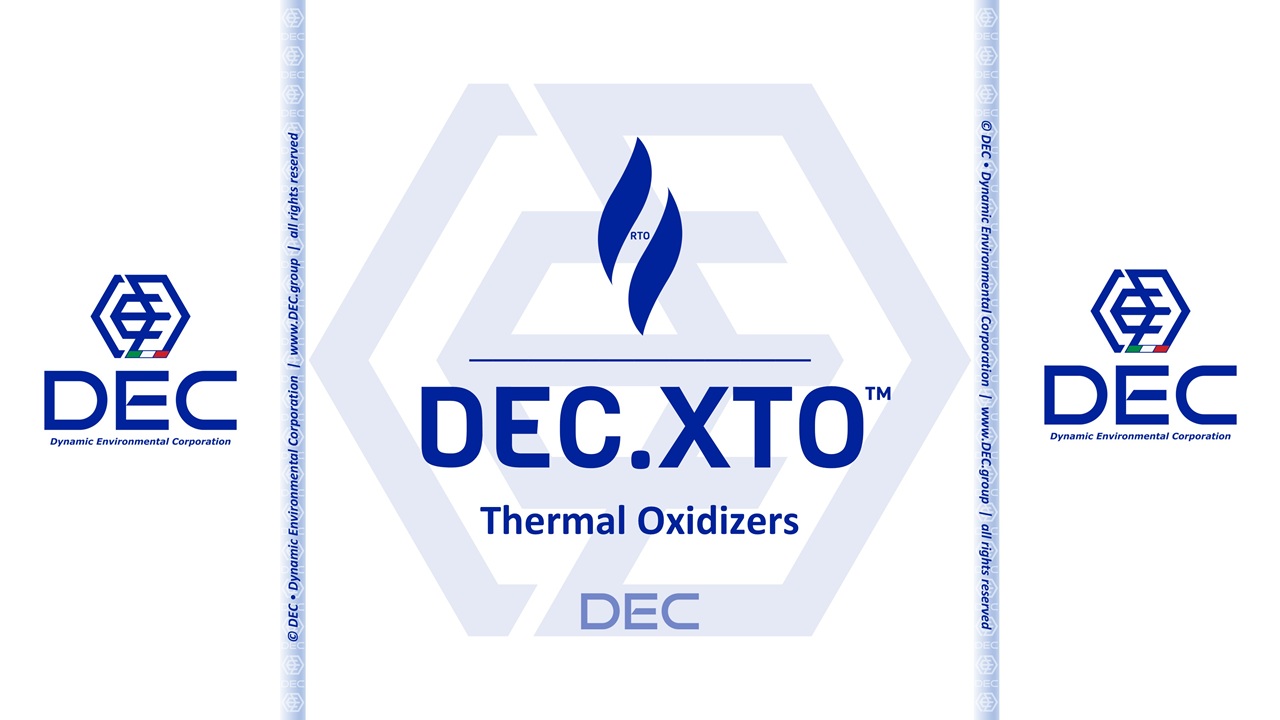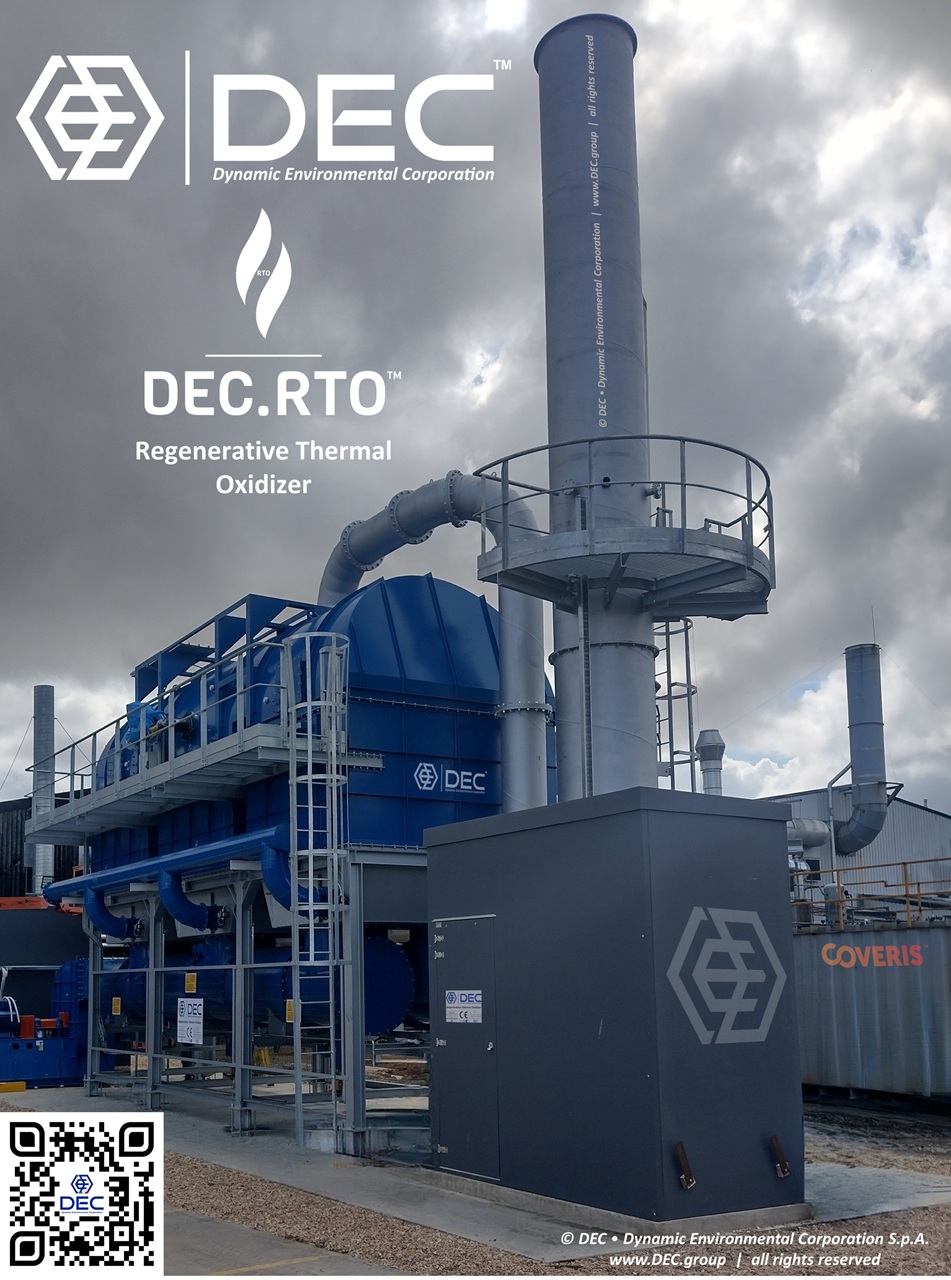
DEC.XTO™ 🔥 Thermal Oxidizers
Thermal Oxidizers (also known as also known as thermal oxidisers, thermal incinerators, fume incinerators, or afterburners) are APC air pollution control devices commonly employed in chemical industries: DEC.XTOs™ operate by decomposing hazardous gases, at high temperatures (typically around 590°C to 980°C), releasing the resulting gases into the atmosphere.
DEC.XTO™ thermal oxidizers primarily target Volatile Organic Compounds (VOCs) present in industrial air streams: these pollutants, typically hydrocarbon-based, undergo thermal combustion, converting them into carbon dioxide (CO2) and water (H2O) through chemical oxidation.
Why Choose DEC for Thermal Oxidizer Solutions: discover cutting-edge thermal oxidizer technology for VOC emission control with DEC, a global leader in sustainable industrial solutions. Our direct-fired, catalytic, and regenerative thermal oxidizers deliver unmatched VOC destruction efficiency, ensuring compliance with stringent environmental regulations. Whether you need a custom thermal oxidizer for VOC control or a high-efficiency regenerative thermal oxidizer to reduce operating costs, DEC’s innovative designs optimize performance and energy savings. Explore the best thermal oxidizer for VOC emission control and learn how our solutions can transform your emissions strategy. Contact us today to elevate your VOC abatement with reliable, cost-effective technology.

thermal oxidation | oxidizers • comprehensive Thermal Oxidizer solutions for VOC Control
DEC offers a full spectrum of thermal oxidizers tailored to your VOC emission control needs, including:
From thermal oxidizer types for VOC reduction to thermal oxidizer performance for VOCs, DEC’s solutions, like DEC advanced thermal oxidizer technology and DEC VOC abatement solutions page, ensure compliance and efficiency. Request a quote for custom thermal oxidizer for VOC control or thermal oxidizer installation for VOC control to meet your goals.
thermal oxidation | oxidizers • oxidation reaction
VOC laden air from the process is drawn into the oxidizer system with the help of the fan system (V-1), then through the combustion chamber(s); the VOCs are heated up to the oxidation temperature and transformed in gases, following this reaction:
VOCs (CxHyOz) + O2 + thermal energy = CO2 + H2O + (HEAT)
The excess heat, when available, is usually recovered to pre-heat the SLA stream, in order to reduce the need of additional "thermal energy" (typically provided through gas CH4 - methane or LPG, or H2 or alternatively or in combination with electic heaters); if producing extra heat through oxidation of solvents, an energy recovery system shall be foreseen (typical applications are ranging from heating up air for dryers, steam production, heat tranfer fluid heating, water heating - industrial or sanitary, etc.).

thermal oxidation | oxidizers • GHG and by-products
An oxidizer is handling the transformation of the pollutant(s) into different products, with a reduced environmental impact. However, it is important to consider the resulting GHG emissions, when selecting a VOC oxidizer; the amount of GHGs generated by a thermal oxidizer depends on the type of VOCs being treated, its quantity, the needed quantity of fuel to be added for sustianing the oxidation reaction and the selected oxidizer process configuration.
Any oxidizer will have to deal with all or most of the following issues:
These emissions contribute to climate change and should be taken into account when assessing the overall environmental impact of the system.
Oxidizers typically require a significant amount of energy to operate: if this energy comes from non-renewable or carbon-intensive sources, this aspect will further contribute to environmental degradation and offset any of the potential benefits of VOC emission reduction.
When the VOC stream is recoverable for direct reuse at site, oxidation technology should generally be avoided: instead, implementing a VOC recovery system (DEC.SRU™ • solvent recovery units) is the environmentally preferable approach, and part of a sustainable strategy (decarbonization).
However, there are some cases where a thermal oxidation technology may be the only viable option. For example, if the VOC stream is too complex to be recovered, or if the quantity of solvents is not enough to make recovery economically feasible or sustainable. In these cases, oxidation technology can be used to safely and effectively destroy VOCs. The decision of which VOC abatement technology to use should be made on a case-by-case basis, taking into account the specific characteristics of the VOC stream and the environmental and economic considerations, always keeping the circular economy drivers in mind when making decisions about VOC abatement.
thermal oxidation | oxidizers • greenwashing
Greenwashing will occur when a company promotes an oxidizer as an environmentally friendly or sustainable technology for VOC emissions control, while neglecting to address other significant negative aspects of its environmental impact, such as greenhouse gas (GHG) emissions and harmful by-products.
Greenwashing can happen when a company portrays an oxidizer as a comprehensive and eco-friendly solution to VOC emissions, creating the perception that it is a sustainable option without considering the complete environmental picture. While oxidizers can help reduce VOC emissions, they can have negative consequences that should not be overlooked.
To avoid greenwashing, companies shall provide transparent and comprehensive information about the environmental impact of their VOC emission control systems: this includes addressing greenhouse gas (GHG) emissions, harmful by-products, and the energy efficiency of the system. By doing so, companies can ensure that consumers have an accurate understanding of the technology's environmental implications and make informed decisions.

